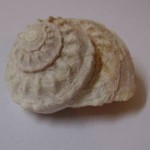 |
Grey Olltwit - Fossils and Dinosaurs |
 |
| Home | Fossil Facts | Dinosaurs | Fossil Finds | Contact | Links |
|
|
GASTROPOD
GASTROPODS (SNAILS) These are a very important group of molluscs. They are characterised by a single coiled shell, although some types, e.g. the limpets, have a simple dome-shaped shell, and in others such as the slugs, the shell is virtually absent. Most gastropods are marine, though there are numerous freshwater types as well as land-living forms (e.g. the common and generally unpopular garden slugs and snails) which have developed 'lungs' to enable them to breathe out of water. Most gastropods feed by scraping up plant material, but many are flesh eaters which use their mouths to drill through the shells of other molluscs to reach their soft bodies. Many fossil species are known, varying greatly in the nature of the coiling of the shell and the surface ornamentation. The first fossils are found in the Cambrian Period. In the rest of the Palaeozoic they are relatively uncommon, but are more abundant in the Mesozoic. It is in the Caenozoic that they really proliferate - some Eocene beds in Southern England are packed with the remains of numerous types, many of which are still alive in modern tropical seas. Most gastropod fossils are fairly small (the smallest being about one millimetre long), but occasional 'giants' such as Campanile from the Tertiary were over 5Ocm in length.
Fossil Facts - What They Are - How They Are Formed - Where To Find Them Dinosaurs - Cetiosaurus - Compsognathus - Diplodocus - Edmontosaurus Euoplocephalus - Gallimimus - Giganotosaurus - Heterodontosaurus - Hypsilophodon Iguanodon - Parasaurolophus - Proceratosaurus - Protoceratops - Rebbachisaurus Stegoceras - Stegosaurus - Titanosaurus - Triceratops - Tyrannosaurus Rex (T Rex) - Velociraptor Fossil Finds - Cyprus - Folkestone, UK - Herne Bay, UK - Lake District, UK Norfolk, UK - Thanet, UK - Walton, UK Educational Software - Links - Contact Us
|
|

